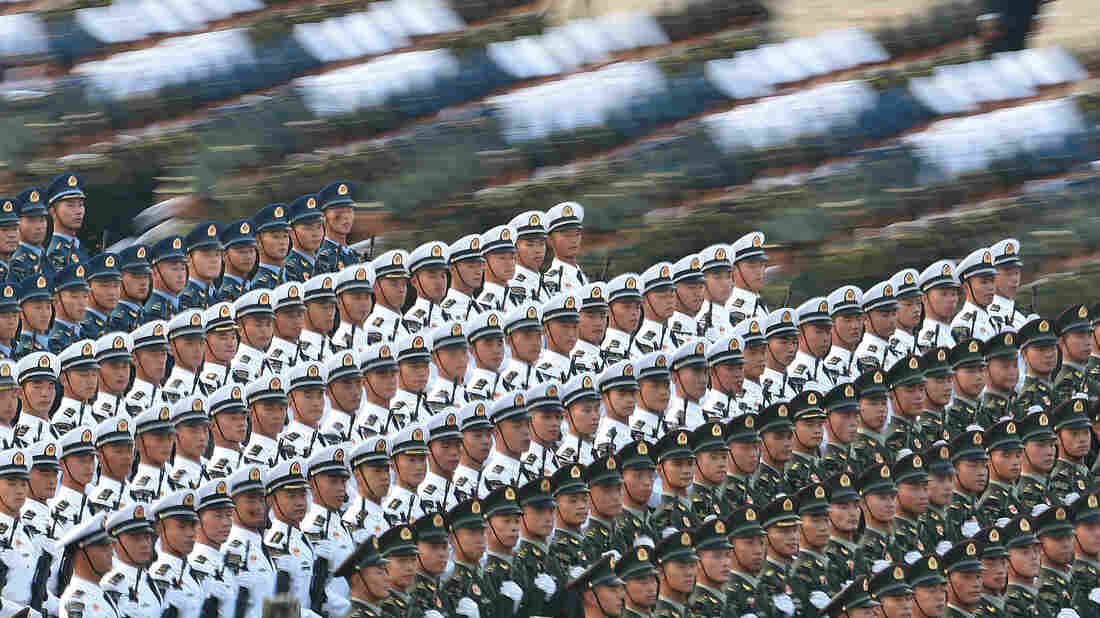
Troops prepare for the military parade marking the 70th anniversary of the founding of the People's Republic of China on Tuesday in Beijing. VCG/VCG via Getty Images hide caption
Near Beijing's center, along Chang'an Avenue or the Avenue of Eternal Peace, more than 100,000 performers and soldiers readied for mass military parade that would unveil China's newest fighting technology, including a hypersonic missile and stealth fighter jets.
At promptly 10 a.m., the parade began with 70 rounds of cannon fire.
The event was the culmination of celebrations of the Chinese Communist Party's 70th year in power. Much of it was dedicated to showcasing military hardware; 160 aircraft flew overhead, while more than 600 tanks, missiles and other weapons systems slowly rolled past carefully selected onlookers throughout the morning.
"There is no force that can shape the foundation of this great nation and no force that can stop the Chinese people and the Chinese nation from getting ahead," Xi Jinping, China's top leader and party chairman, said in an opening speech. He framed the parade as a moment of triumph over the "humiliation" of foreign imperialism beginning with the Opium Wars of the mid-19th century.
Tuesday's celebrations were first and foremost a projection of military might, now technologically advanced enough to counter the U.S. military presence in the Asia-Pacific region.
Since 2015, Xi has consolidated his direct control over China's now 2 million person-strong People's Liberation Army (PLA). An ambitious modernization effort trimmed the force by 300,000 and restructured its command system from seven to five zones. That allowed the PLA to streamline operations – and laid the foundations for Xi to purge three top generals in the following years.
Among the military hardware shown to the public for the first time: 16 of the long-anticipated Dongfeng-41, China's longest-range intercontinental ballistic missile, which is capable of reaching the United States with nuclear warheads. Onlookers were also given the first glimpse of the Dongfeng-17, a medium-range missile that can travel at hypersonic speeds with the aim of breaking through U.S. anti-missile shields.

Military vehicles equipped with the latest DF-41 ballistic missile roll by during the parade to commemorate the 70th anniversary of the founding of Communist China in Beijing on Tuesday. Ng Han Guan/AP hide caption
Military analysts had closely monitored satellite images of Chinese military facilities and nearby traffic for signs of the missile being readied for display.
The Chinese military might be building a new type of missile silo at its new training area near Jilantai. Satellite images from @DigitalGlobe/@maxar show construction well underway. They also show dozens of new DF-41, DF-31AG, DF-26, and DF-21 launchers. https://t.co/kqLgTqGzyB pic.twitter.com/2R2qlQ3SUL
— Hans Kristensen (@nukestrat) September 3, 2019
The pomp and circumstance of Beijing's celebrations were in stark contrast to another day of mass protests planned in the city of Hong Kong against Beijing's influence and for democratic reforms.

Police officers detain a pro-government supporter during clashes with demonstrators in the Wan Chai district of Hong Kong on Tuesday. Bloomberg/Bloomberg via Getty Images hide caption
Protestors attempted to disrupt a flag-raising ceremony commemorating the anniversary earlier Tuesday morning, but the ceremony's participants continued by watching from inside an adjacent convention center. Several of Hong Kong's busiest metro stops were closed in anticipation of another day of mass protests, now in their 17th week. A march planned for the afternoon did not get permission from Hong Kong police, but protestors say they will convene anyway.
Xi's brief opening speech Tuesday included strong language reiterating Beijing's control over Hong Kong and the nearby island of Taiwan: "We will maintain long term prosperity and stability of Hong Kong and Macau, advance peaceful development of cross strait relations, unite the whole country and continue to strive forward with complete unification of our country."
Hong Kong's embattled Chief Executive Carrie Lam was in Beijing as a guest of honor at the parade, seated overlooking Tiananmen Square in the second row of the box reserved for officials.
Beijing's parade was also an important show of party unity. Xi appeared flanked by the six other members of the powerful Communist Politburo standing committee.
He was also accompanied by his predecessors — Hu Jintao and 93-year-old Jiang Zemin, whose death has been frequently rumored. Jiang was very much alive, albeit held up by two assistants.
Amy Cheng contributed reporting from Beijing.
https://www.npr.org/2019/10/01/765948838/china-flexes-muscles-in-parade-marking-70-years-of-communist-rule
2019-10-01 06:06:00Z
52780396822607
Tidak ada komentar:
Posting Komentar